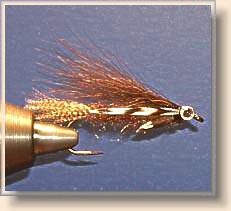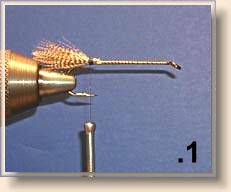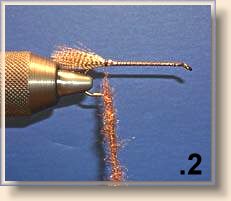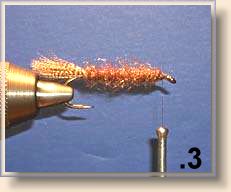
Step 3: Wrap the dubbing forming a streamlined body. Be sure
to leave enough space to tie in the deer hair and finish off
the head.
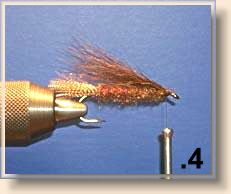
Step 4: Attach the dark brown/olive bucktail so that the hair
extended to the end of the tail.
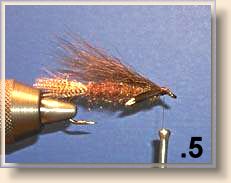
Step 5: Get two starling breast feathers with white tips.
The feathers need to be the appropriate size as to resemble
the pectoral fins. Use some head cement to make the feathers
more durable. Once the feathers are dried, secure one on each
side angled downward at about 30 degrees. Be sure to secure
them so that the tips of the feathers are curved outward.
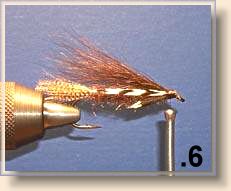
Step 6: Get two same sized grizzly hackles. Trim them to size
so that the feather will run from the head to just forward of
the tail. Once the feathers are trimmed to size coat each
feather lightly with head cement for added durability. Once
dry, secure one feather to each side so that the feather is
curved inward.
Step 7: (Optional) Add a small patch of the red sheep on either
side for gills.
Step 8: Attach two 2mm eyes and give the head a coating of
glossy head cement.
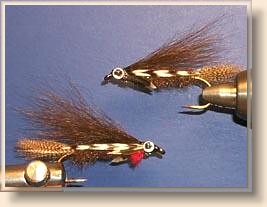
Step 9: Dampen in your local waters and enjoy the day.
Fishing Suggestions:
JP's Trout Snack is not the prettiest fly you've ever seen,
but it is very effective. One point I want to make is to be
sure not to skip the step where you attach the eyes. I am a
firm believer that eyes are essential on a baitfish pattern.
Having gotten my college BS in Biology/Fisheries Science I
have spend quite a lot of time observing and studying fish.
There are numerous species out there that have false eye
spots, generally on their tail. This is so that a predator
may mistakingly attack the fishes tail, thus allowing the
prey a chance to escape. Mother Nature does everything for
a reason. Natural selection culls out the inferior so that
only the strong survive. Fish have these eyespots for a reason
so take note and use that to your advantage. Obviously, in
stained or cloudy water, this is less important, but in clear
water, eye's on your bait patterns can really make the difference.
Just something to keep in mind.
One other quick item of note is the use of red for the gills.
If fish are hungry they will feed. That's pretty basic stuff,
nothing earth shattering in that statement. But, when a fish
is not hungry or in a negative feed pattern, a little red can
make the difference. A fish may not be looking for a meal,
but if an easy meal presents itself rarely will it be refused.
Fishing the gin clear waters off Key West we witnessed just
this scenario. There were King Mackerel, False Albacore and
Blackfin Tuna around the boat, but they just were not showing
much interest in the live pilchards that we were pitching off
the back of the boat. But, if you took one and gave it a
squeeze or thumped it against the boat before tossing it
overboard the fish would attack it immediately.
Another good example presented itself this past October while fishing
in Amazonia. We were fishing for Peacock Bass and gave the
fly rods (and our arms) a rest. I was casting a floating
Rapala into a group of fish. If I just reeled the lure in
the fish showed no interest. However, if I reeled it in
slowly with a very erratic retrieve the fish ganged up on
it, often resulting in two fished hooked on the same lure.
Although the fish were not actively feeding, they could not
resist an easy meal. Adding gills to a baitfish pattern adds
to its realism and also gives the perception that the fish may
be injured and thus trigger a strike response. I urge you to
pay close attention to what is going on around you. Keen
observation can produce some very effective techniques and
memorable days. ~ Jeff Pierce
About Jeff Pierce:
Jeff Pierce, AKA Dr. Fish, is the North American Sales
Coordinator for O. Mustad & Son (USA), Inc and Partridge
of Redditch. He is the Captain of Team Mustad USA and is
a diehard angler and fly tier. He has traveled from Buffalo
to Borneo in search of finned quarry to grapple with. For more
of his innovative flies check out the bottom of the
Mustad Sponsor page!
For more great flies, check out:
Beginning Fly Tying and
Intermediate Fly Tying.
|

